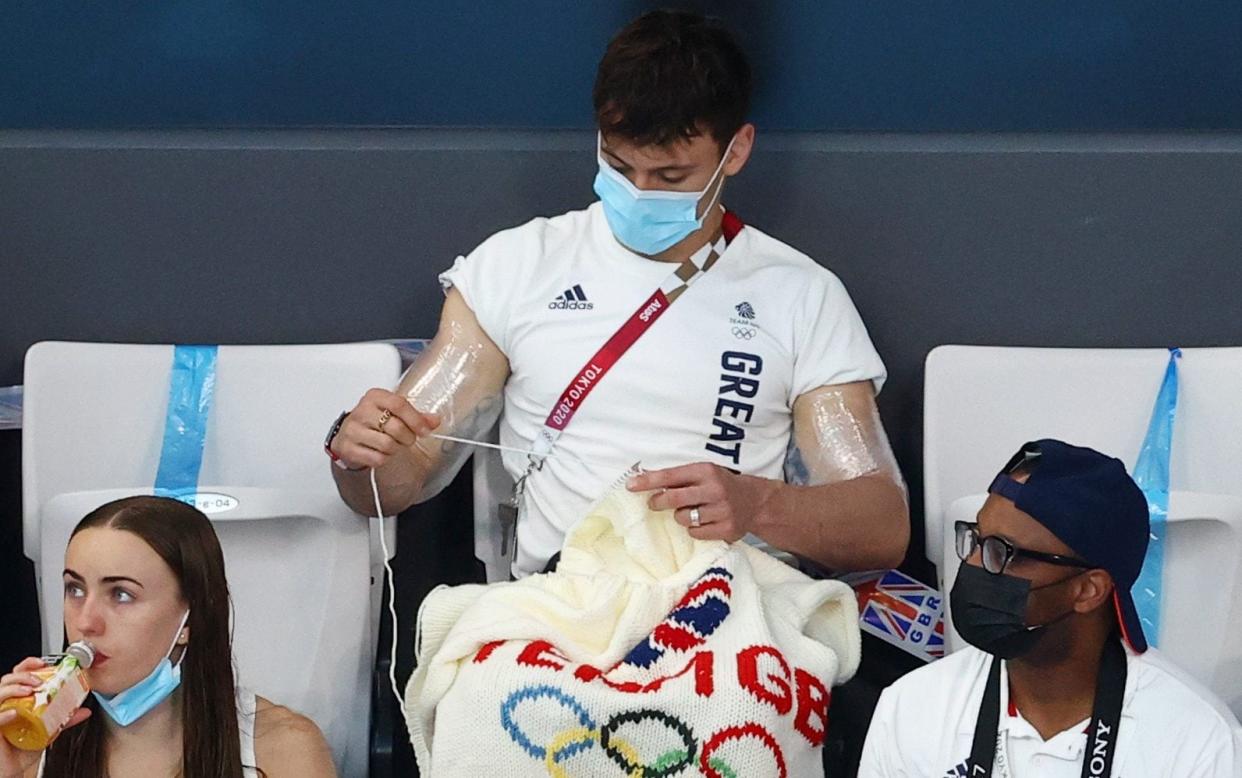Tom Daley and the calming power of knitting

- Oops!Something went wrong.Please try again later.
How does an Olympic athlete unwind? Forget infrared saunas or luxury sport massages – the answer is with two needles and some thread.
Last week, Olympic diver Tom Daley shared a post on Instagram detailing how knitting and crocheting helped to keep him calm in the lead up to the Olympics. To commemorate his gold medal, he even knitted a union-jack patterned case to store his Olympic gold medal in, and posted a picture on Instagram.
Over the weekend, a picture emerged of Daley watching the women’s 3m springboard final in Tokyo while knitting with purple wool. “There's Tom Daley – he’s got his knitting needles out,” said BBC commentator Katherine Downes, during live coverage on Sunday morning. “What do you reckon he’s crafting there? I wonder who he’s making that purple concoction for?”
In recent years, knitting has grown in popularity among millennials. In 2018, market research firm Mintel reported a 12 per cent rise in women doing some sort of needlecraft as a hobby in the last two years. A fifth of women under 45 were interested in taking up knitting and sewing, while 17 per cent of men aged 16 to 24 were keen to try one of these pastimes. In lockdown, many newbies turned to knitting as both a creative pursuit and a coping mechanism. The website LoveCrafts.com reported a significant growth in interest during the early stages of the pandemic; 71 per cent of visitors were new to the site, and yarn and knitting patterns received the most traffic overall.
Little wonder, when the links between knitting and mental health are well documented. Research in 2018 by Knit for Peace, a network of over 15,000 knitters in the UK who knit for people in need, found that the hobby can reduce depression and anxiety, slow the onset of dementia and even distract from chronic pain. One of the studies analysed by the group, conducted by Harvard Medical School’s Mind and Body Institute in 2007, found that knitting can actually lower our heart rate by an average of 11 beats per minute, and creates an “enhanced sense of calm” that replicates the feelings induced by yoga. A 2009 study of 38 women with anorexia found that learning to knit led to significant improvements. Seventy-four per cent of the women said the activity lessened their fears and kept them from ruminating about their problem.
If you’re in need of proof, look no further than social media, which is full of people extolling the benefits of the hobby. One Twitter user posted a picture of themselves modelling a jumper they had knitted, with the caption: “I took up knitting at the start of Covid 2020. I’ve found it so calming, I’ve knitted five snoods, three cushions, one blanket and three jumpers (cost a small fortune) – this one I finished today and is my favourite (hardest) I’m already looking at what to do next #mentalhealth #Wellbeing”
Another user wrote: “I find knitting very calming, especially for breaks in projects where I feel like I’m not making tangible progress. No-one can take the rows you knit away from you!”
The reason knitting calms us down is that it helps to anchor us in the present moment, says environmental psychologist Lee Chambers. “It’s not something you can do at speed, there’s a rhythmic flow to it, and you’re in control of the motion. That's why knitting can be an excellent form of accessible mindfulness for people who find it difficult to slow down through things like mediation,” he says. “In elite sport there are so many variables around you, but knitting is something you can control. That, in itself, feels very therapeutic.”
The rhythmic motion of knitting also helps our brains to release serotonin, the hormone that stabilises our mood, feelings of wellbeing, and happiness. There is even evidence that the hobby can stave off brain decline: research from 2011 found that those who engaged in crafts like knitting and crocheting had a diminished chance of developing mild cognitive impairment and memory loss.
As far back as the First World War, people were experimenting with the soothing power of knitting. The hobby was initially prescribed to shell-shocked soldiers to see if it would distract them from the trauma of the trenches. A few years later, an organisation called the Disabled Soldiers’ Embroidery Industry was formed. The establishment gave ex-servicemen the opportunity to earn some income through knitting, and rebuild their self-esteem.
More recently, knitting has been used in prisons to help give inmates a sense of purpose. Fine Cell Work is one of the UK-based charities that teaches prisoners high quality needlework, which “boosts their self-worth, instills self-discipline, fosters hope and encourages them to lead independent, crime-free lives.”
Knitting might come across as a solitary activity, says Chambers, but it has a social aspect too. “People can knit with communities online. When you knit, you’re creating something from nothing, working towards an outcome that you can physically hold in your hand. We live in such a disposable culture, so that feeling is really powerful,” he says.

